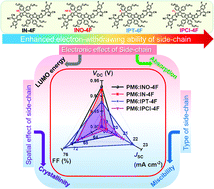Charge density modulation on asymmetric fused-ring acceptors for high-efficiency photovoltaic solar cells†
Abstract
Charge density modulation on a thieno[2′′,3′′:5′,6′]-s-indaceno[2′,1′:4,5]dithieno[3,2-b:2′,3′-d]pyrrole (IPT) core has been conducted for a systematic study of its impact on the electronic structure, molecular packing and photovoltaic performance of asymmetric fused-ring acceptors (FRAs). Herein, a series of IPT-based FRAs (i.e.IN-4F, INO-4F, IPT-4F and IPCl-4F) are designed by incorporating 2-ethylhexyl, 2-ethylhexyloxy, hydrogen and chloro side chains, respectively, onto the IPT core. Enhancing the electron-withdrawing ability of the side-chains decreases the optical bandgap but lowers the lowest unoccupied molecular orbital (LUMO) level, which yields a trade-off between JSC and VOC in organic solar cells (OSCs). Furthermore, the FRAs exhibit tunable miscibility and crystallinity, reflected in the FF and JSC values of the OSCs. By pairing with polymer donor PM6, IPT-4F based devices achieve the highest PCE of 14.62% with a balanced VOC of 0.88 V and JSC of 22.15 mA cm−2 and a high FF of 75.01%. Our research demonstrates that electronic density modulation on asymmetric FRAs is an effective way to systematically optimize the device parameters in pursuit of high performance OSCs.



 Please wait while we load your content...
Please wait while we load your content...